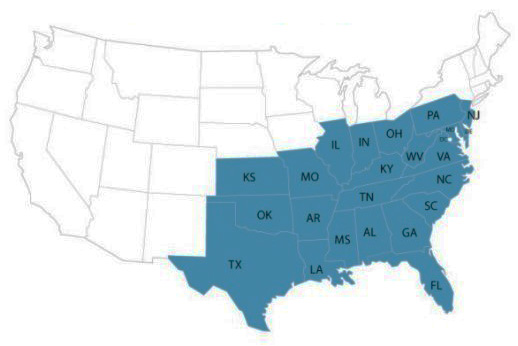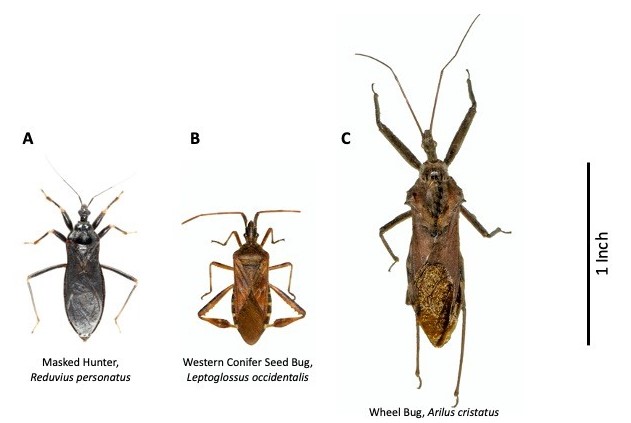No
Kissing Bugs in Nebraska
During the summer of 2020, entomologists from the Nebraska Department of Agriculture and University of Nebraska-Lincoln Department of Entomology identified a species of kissing bug for the first time in Nebraska.
“Kissing bug" is the common name for a group of bugs called triatomines. These are blood-sucking insects that are found across the Southern United States, Mexico, Central, and South America especially during the summer months. The species recently detected in Nebraska was identified as Triatoma sanguisuga or the Eastern blood-sucking conenose (Figure 1). This species has been found as far north as Pennsylvania and as far west as Texas (Figure 2).
The main risk associated with kissing bugs is the presence of a parasite called Trypanosoma cruzi (T. cruzi for short) that lives in the bug's intestines and is shed in feces. This parasite can cause Chagas disease in the people and animals it infects. Although infections from this parasite are not common, approximately 25% of people that are infected develop serious chronic disease, so early diagnosis is important. Importantly, infections from the Eastern blood-sucking conenose are even rarer and the risk of infection in Nebraska is considered to be very low. However, some of the collected kissing bugs were tested for the presence of T. cruzi with several testing positive for the parasite. This is the first recorded detection of this parasite in Nebraska.
Anyone who has seen kissing bugs in their home or who thinks they may have been bitten by one should talk to their doctor about getting tested for Chagas disease.
The Nebraska Department of Health and Human Services and University of Nebraska-Lincoln Department of Entomology is working to raise awareness of the detections of kissing bugs and T. cruzi within Nebraska. We have put together some basic information and resources on Chagas disease and kissing bugs. Read on to learn more.
If you think you have found a kissing bug, please fill out the form below and someone from our team will be in contact.
Kissing Bug Photo Submission Form
What is a kissing bug?
Figure 1.  Triatoma sanguisuga
Triatoma sanguisugaKissing bugs are insects that can carry a parasite that causes Chagas disease. Kissing bugs are also known as triatomines, conenose bugs, or chinches. They usually feed on blood during the night, when animals or people are asleep or inactive. The bites are often painless and many people do not even realize they have been bitten.
Figure 1. Species of Kissing Bugs and Chagas Disease in the United States; Texas A&M Agriculture and Life Sciences; Texas A&M Veterinary Medicine and Biomedical Sciences (https://kissingbug.tamu.edu/ )
There are 11 different kinds of kissing bugs in the United States. Most of the reports of the different kissing bugs have come from Arizona, California, New Mexico, and Texas. Kissing bugs have been found and documented in the U.S. as early as the mid-1800s. These species are not new to the U.S. and not all kissing bugs will be infected with the parasite.
The Eastern blood-sucking conenose is approximately ¾ inches long with a blackish, flattened, and elongated body. The sides of the abdomen extend out beyond the wings, showing six reddish-orange horizontal markings on each side. There are also four distinctive reddish-orange markings on wings.
Figure 2.
 Distribution of Triatoma sanguisuga (Eastern blood-sucking conenose)
Distribution of Triatoma sanguisuga (Eastern blood-sucking conenose)
Look-alike species that are confused for kissing bugs
Don't be fooled, there are several insect species found in Nebraska that look like kissing bugs but are not true kissing bugs.
Figure 3.
 Insect species confused for kissing bugs:
Insect species confused for kissing bugs:
A. Masked Hunter; B. Western Conifer Seed Bug; C. Wheel Bug
Where are kissing bugs typically found?Kissing bugs can live indoors, in cracks and holes of housing, or in a variety of outdoor settings including:1
- Beneath porches
- Between rocky structures
- Under cement
- In rock, wood, brush piles, or beneath bark
- In rodent nests or animal burrows
- In outdoor dog houses or kennels
- In chicken coops or houses
They are mostly nocturnal and are often attracted to lights such as porch lights. Their bite is often painless and usually occurs when a person is still or asleep.
What is Chagas disease?
Chagas disease, also called American trypanosomiasis, is a potentially deadly disease caused by the parasite Trypanosoma cruzi. This parasite is spread to people and animals by the feces of infected kissing bugs. When a kissing bug takes a blood meal, it may defecate and leave behind the parasite on the skin. When feces are rubbed into the wound, including areas in or around the eyes or nose, the parasite enters the host. Other less common ways to get Chagas disease are from mother-to-fetus, blood transfusions (rare), organ transplantation from an infected donor, or contaminated food or drink (rare).
Chagas disease can be difficult to identify, and many of the people who have the disease do not have symptoms until years or even decades after being infected. Chagas disease has two important phases.
Acute Chagas Disease
This phase happens immediately after infections and can last about 8–10 weeks. During this phase, parasites may be found in the circulating blood. This phase of infection is usually mild or with no symptoms at all. Some may experience a fever or swelling around the bite site. It is rare to diagnose Chagas disease during this phase.
Chronic Chagas Disease
Following the acute phase, most infected people enter into a prolonged form of the disease called chronic Chagas disease. During this phase, parasites are not found in the blood and there are often no symptoms. Most people are unaware of their infection and may remain without symptoms for life. However, an estimated 20–30% of infected people will go on to develop severe and sometimes life-threatening medical problems over the course of their lives. These may include:
- Heart rhythm abnormalities that can cause sudden death
- A dilated heart that doesn't pump blood well
Chagas disease can reactivate with parasites found in the circulating blood in people who have suppressed immune systems (for example, due to HIV infection or chemotherapy). Reactivation can potentially cause severe disease. Chagas disease often is a life-long diagnosis; however, there are treatment options available, requiring regular follow-ups with your doctor.
There are no known impacts on livestock, but dogs have been known to be affected by Chagas.
Chagas Disease Diagnosis and Treatment
If you have had contact with a kissing bug or think you may have Chagas disease, you should discuss your concerns with your doctor, who will examine you and ask you questions (for example, about your health and where you have lived). Chagas disease is diagnosed by blood tests.
If you are found to have Chagas disease, your doctor may recommend follow-up monitoring of the heart (electrocardiogram), even if you feel healthy. You might be referred to an infectious disease specialist for more tests or for treatment. Because the disease is rare in the United States, many doctors may not be familiar with Chagas disease. It may be helpful to share resources with your physician.2
So, what do I do if I find a kissing bug?
First of all, don't panic. Chagas disease is uncommon in the United States and contact with a single kissing bug does not mean someone will get Chagas disease. The kissing bug must be infected with the parasite, have defecated while taking a blood meal, and feces must enter the bite wound or mucus membrane in order for someone to contract Chagas disease. This route of transmission is very inefficient and studies estimate that a person is bitten by an infected kissing bug many times before transmission is successful.
If you reside in Nebraska and capture a bug that you know or suspect has bitten you or someone in your home, get the bug tested for the parasite. The Nebraska Department of Health and Human Services Vector-Borne Disease Program will accept kissing bugs for identification (call (402) 471-2937). If the bug is identified as a kissing bug, it will be forwarded to the CDC to be tested for the parasite that causes Chagas disease.
However, they must have been found inside the home or be suspected of having bitten someone. If the kissing bug tests positive, it is recommended you speak with your doctor about getting tested. You must wait until past the 8–10 weeks of the acute phase before testing for antibodies. Chagas disease antibody tests may give a falsely negative result if taken too soon after exposure. The diagnosis MUST be confirmed before any treatment options are provided.
To submit a photo of the potential kissing bug, please fill out the form below and someone from our team will be in contact.
Information for Healthcare Providers
If you have a patient that you suspect may have been bitten by a kissing bug or could fit the risk factors for someone with Chagas disease, the following is a summary of helpful information with regards to diagnosis and treatment.
During the acute phase (the first 8–10 weeks) the parasites may be found in blood smears by microscopic examination. However, circulating parasite levels decrease rapidly and are often missed or may not be found at all. It is rare to be diagnosed during this phase.
Diagnosis of chronic Chagas disease is made by serologic tests. These tests must be done AFTER the 8–10 weeks window of an acute infection. This testing can be done by commercial laboratories. If the test is positive, further testing should be done to confirm the diagnosis. Confirmatory testing can be requested at the Centers for Disease Control and Prevention (CDC) through the Nebraska Department of Health and Human Services or local health department. Because a single test is not sufficiently sensitive or specific to make the diagnosis, a two-step process is necessary.
There is currently an FDA approved treatment for Chagas disease. Benznidazole is available by prescription only through an online pharmacy. The diagnosis of Chagas disease should be confirmed before recommending treatment. Please refer to the CDC for additional information for healthcare providers and Chagas disease diagnosis and treatment.2
Additional Resources:
CDC Chagas Disease Page
Cited Sources: